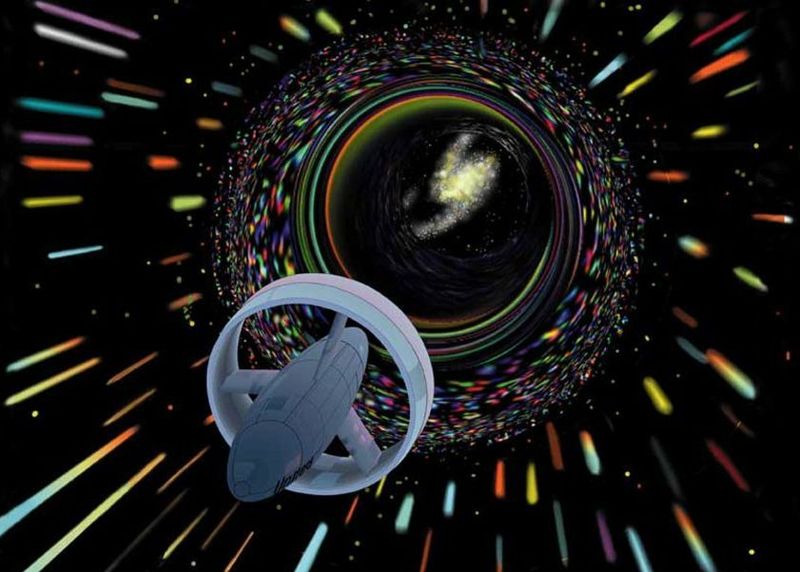Move over Star Trek! According to state-of-the art theory, a warp drive could cut the travel time between stars from tens of thousands of years to weeks or months. Harold G. White, a physicist and advanced propulsion engineer at NASA and other NASA engineers are trying to determine whether faster-than-light travel — warp drive — might someday be possible. The team has attempting to slightly warp the trajectory of a photon, changing the distance it travels in a certain area, and then observing the change with a device called an interferometer.
“Space has been expanding since the Big Bang 13.7 billion years ago,” said Dr. White, 43, who runs the research project told the New York Times. “And we know that when you look at some of the cosmology models, there were early periods of the universe where there was explosive inflation, where two points would’ve went receding away from each other at very rapid speeds. Nature can do it,” he added. “So the question is, can we do it?”
In 1994, a Mexican physicist, Miguel Alcubierre, theorized that faster-than-light speeds were possible in a way that did not contradict Einstein by harnessing the expansion and contraction of space itself. Under Dr. Alcubierre’s hypothesis, a ship still couldn’t exceed light speed in a local region of space. But a theoretical propulsion system he sketched out manipulated space-time by generating a so-called “warp bubble” that would expand space on one side of a spacecraft and contract it on another.
An Alcubierre Warp Drive stretches spacetime in a wave causing the fabric of space ahead of a spacecraft to contract and the space behind it to expand. The ship can ride the wave to accelerate to high speeds and time travel. The Alcubierre drive, also known as the Alcubierre metric or Warp Drive, is a mathematical model of a spacetime exhibiting features reminiscent of the fictional “warp drive” from Star Trek, which can travel “faster than light/”
“In this way, the spaceship will be pushed away from the Earth and pulled towards a distant star by space-time itself,” Dr. Alcubierre wrote. Dr. White, the NYT reports, has likened it to stepping onto a moving walkway at an airport.
Alcubierre’s theory, however, depended on large amounts of a little understood or observed type of “exotic matter” that violates typical physical laws.
In general relativity, one often first specifies a plausible distribution of matter and energy, and then finds the geometry of the spacetime associated with it; but it is also possible to run the Einstein field equations in the other direction, first specifying a metric and then finding the energy-momentum tensor associated with it, and this is what Alcubierre did in building his metric. This practice means that the solution can violate various energy conditions and require exotic matter. The need for exotic matter leads to questions about whether it is actually possible to find a way to distribute the matter in an initial spacetime which lacks a “warp bubble” in such a way that the bubble will be created at a later time.
Yet another problem according to Serguei Krasnikov is that it would be impossible to generate the bubble without being able to force the exotic matter to move at locally FTL speeds, which would require the existence of tachyons. Some methods have been suggested which would avoid the problem of tachyonic motion, but would probably generate a naked singularity at the front of the bubble.
Dr. White believes that advances he and others have made render warp speed less implausible. Among other things, he has redesigned the theoretical warp-traveling spacecraft — and in particular a ring around it that is key to its propulsion system — in a way that he believes will greatly reduce the energy requirements. But ”We’re not bolting this to a spacecraft,” he said of the technology.
Richard Obousy, a physicist who is president of Icarus Interstellar, a nonprofit group composed of volunteers collaborating on starship design, said “it is not airy-fairy, pie in the sky. We tend to overestimate what we can do on short time scales, but I think we massively underestimate what we can do on longer time scales.”
Dr. White likened his experiments to the early stages of the WW11 Manhattan Project, which were aimed at creating a very small nuclear reaction merely as proof that it could be done.
“Routine travel among the stars is impossible without new discoveries regarding the fabric of space and time, or capability to manipulate it for our needs,” says Neil deGrasse Tyson, astrophysicist at the American Museum of Natural History, said “By my read, the idea of a functioning warp drive remains far-fetched, but the real take-away is that people are thinking about it — reminding us all that the urge to explore continues to run deep in our species.”
Still, one of the most dubious is Dr. Alcubierre himself. He listed a number of concerns, starting with the vast amounts of exotic matter that would be needed. “The warp drive on this ground alone is impossible,” he said. “At speeds larger than the speed of light, the front of the warp bubble cannot be reached by any signal from within the ship,” he said. “This does not just mean we can’t turn it off; it is much worse. It means we can’t even turn it on in the first place.”
The Daily Galaxy via New York Times and Dr. David Lewis Anderson/Anderson Institute
Image credit: With thanks to http://www.patrickshrier.com/tag/alcubierre-drive/
Related articles





